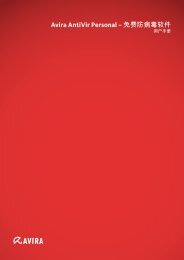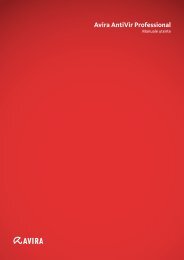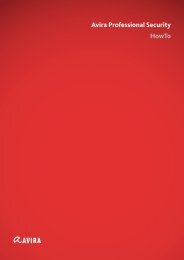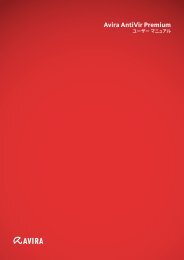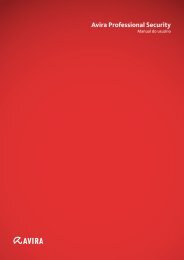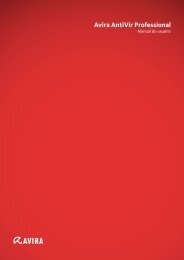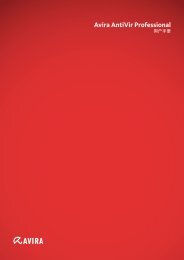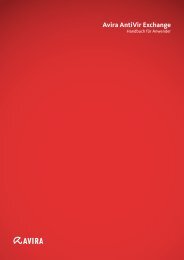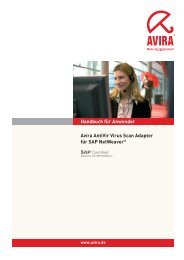User Manual
User Manual
User Manual
You also want an ePaper? Increase the reach of your titles
YUMPU automatically turns print PDFs into web optimized ePapers that Google loves.
Delete<br />
Reference: Configuration options<br />
With this button you can delete a selected file object from the display window.<br />
Please note the further information when specifying exceptions:<br />
In order to also exclude objects when they are accessed with short DOS file names (DOS<br />
name convention 8.3), the relevant short file name must also be entered in the list.<br />
A file name that contains wildcards may not be terminated with a backslash. For example:<br />
C:\Program Files\Application\applic*.exe\<br />
This entry is not valid and not treated as an exception!<br />
Please note the following with regard to exceptions on connected network drives: If you<br />
use the drive letter of the connected network drive, the files and folders specified are NOT<br />
excluded from the Realtime Protection scan. If the UNC path in the list of exceptions<br />
differs from the UNC path used to connect to the network drive (IP address specification in<br />
the list of exceptions – specification of computer name for connection to network drive),<br />
the specified folders and files are NOT excluded by the Realtime Protection scan. Locate<br />
the relevant UNC path in the Realtime Protection report file:<br />
\\\\ - OR - \\\\<br />
You can locate the path Realtime Protection uses to scan for infected files in the Realtime<br />
Protection report file. Indicate exactly the same path in the list of exceptions. Proceed as<br />
follows: Set the protocol function of the Realtime Protection to Complete in the<br />
configuration under Realtime Protection > Report. Now access the files, folders, mounted<br />
drives or connected network drives with the activated Realtime Protection. You can now<br />
read the path to be used from the Realtime Protection report file. The report file can be<br />
accessed in the Control Center under Local protection > Realtime Protection.<br />
If you are managing the Avira product in AMC, you can use variables in the path details for<br />
process and file exceptions. You can find a list of variables you can use under Variables:<br />
Realtime Protection and Scanner Exceptions.<br />
Examples for processes to be excluded:<br />
� application.exe<br />
The application.exe process is excluded from the Realtime Protection scan, irrespective<br />
of which hard disk drive it is located on and which directory it is in.<br />
� C:\Program Files1\Application.exe<br />
The process for the file application.exe, which is located under the path C:\Program<br />
Files1, is excluded from the Realtime Protection scan.<br />
� C:\Program Files1\*.exe<br />
All processes for executable files located under the path C:\Program Files1 are<br />
excluded from the Realtime Protection scan.<br />
Avira Professional Security - <strong>User</strong> <strong>Manual</strong> (Status: 30 Mar. 2012) 111



